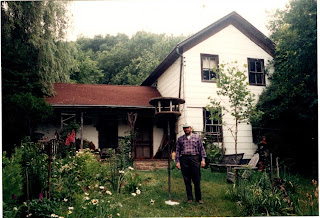July 26, 2020
Dennis and I took a trip up to Woodland township, Sauk county to see if we could find the old Goodman homestead and then to visit Goodman graves at St. Patrick’s cemetery outside Hillsboro. Using a combination of 1859 and 1906 plat maps, a modern highway map of Wisconsin, two pictures of the homestead, one from about 1901, the other from 1992, and relying on my memory of a visit many years ago, we were able to locate the homestead. It had changed greatly since I had seen it last. The barn that had stood to the left of the house was gone and there was a new pole barn standing to the right of the house. The house looked dilapidated, but it did look like it was being worked on. There was a new roof and a portion of the exterior was covered in sheathing. There was a lot of vegetation standing in front of it which made it difficult to see the entire building. When I had seen the house previously there was a pretty pond that stood between the road and the house. The pond was no longer visible but it was easy to see where the pond was located as the area was full of cattails. Even after driving by the home once, and then returning to it again, I was still not completely sure that we had found the correct location until I saw this.
As we were backing out of the driveway I noticed this battered, old mailbox with the “GOODMAN BROS” logo attached to it. Then I felt sure that we had indeed found the original homestead of the Goodman family. This land was purchased in 1855 by Thomas and Bridget Keenan Goodman for $100. The original purchase was for 84 acres. The couple purchased more land in future years. The house is located at E138 Krause Road, Woodland township, Sauk county. It is a narrow gravel road that runs right at the border of Sauk and Richland county.
This photo is from 1992 and shows Francis Goodman standing in front of the Goodman homestead.
It was not possible to get a picture of the house without trespassing on the property but we were able to see the 2 story portion of the house through the woods as we were driving by. This picture only allows one to see the single story portion of the house. A new roof is evident and there is a ladder propped against the left side of the house showing evidence that work is being done. It will be interesting to visit again in the future.




Comments
Post a Comment